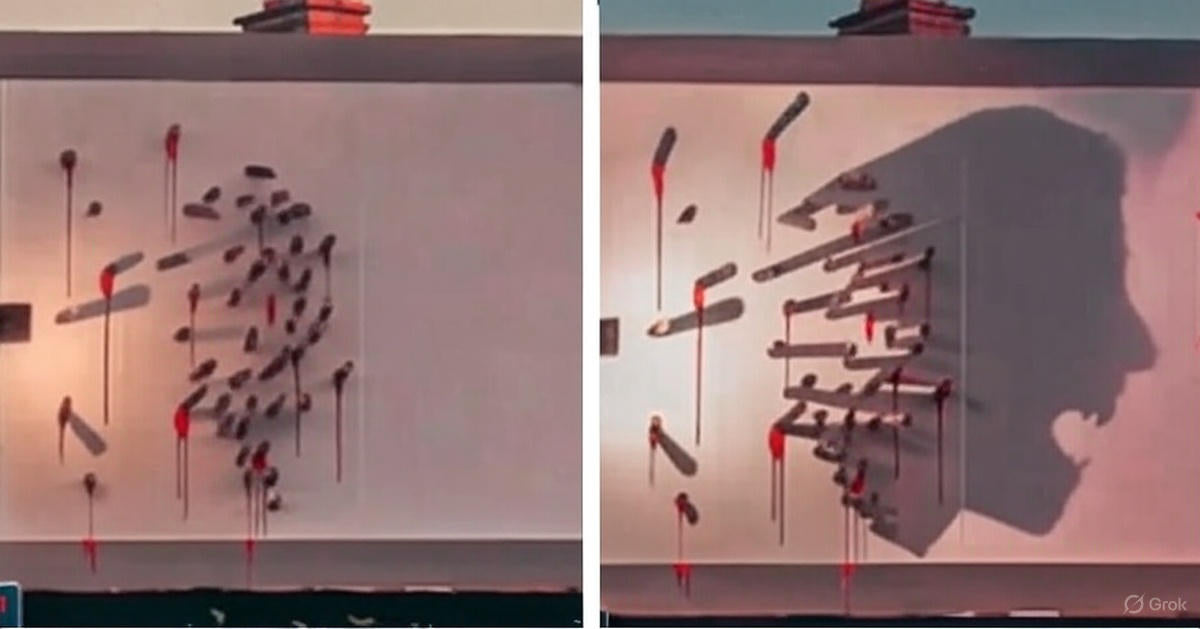BBC Dracula Billboard’s Shadow Illusion Goes Viral Again in 2025
Introduction
A chillingly clever billboard from BBC’s 2020 Dracula series has once again gone viral on social media—this time thanks to a post on X (formerly Twitter) by user @gunsnrosesgirl3 (Science Girl). Her post, published on October 8, 2025, reignited global fascination with what many consider one of the most innovative advertising stunts ever created.
The short clip shows how, as daylight fades, the billboard’s wooden stakes cast shadows that morph into the sinister face of Count Dracula—a masterful play of light, illusion, and storytelling.
Film billboard where portrait of Dracula appears at night from shadows of stakes
— Science girl (@gunsnrosesgirl3) October 8, 2025
pic.twitter.com/cSxDD3SycA
The Viral X Post: How It All Started
The viral post (ID 1975902974934421669) has amassed:
- 166,009 likes
- 8,429 reposts
- 386 quotes
- 361 replies
- 10,003 bookmarks
- Over 6.7 million views
Its caption:
“Film billboard where portrait of Dracula appears at night from shadows of stakes.”
The video, roughly 19 seconds long, captures the transformation from day to night — and as the artificial lights turn on, Dracula’s face appears in the shadows.
At the base of the billboard sits a red emergency box labeled “In Case of Vampires — Break Glass”, complete with a stake inside — adding an extra layer of creativity and dark humor.
This billboard design takes the shape of Dracula when the sun sets pic.twitter.com/lGCY467ers
— The Random Guy (@RandomTheGuy_) October 8, 2025
A Masterpiece of Design and Engineering
Originally created in January 2020, this billboard was part of BBC’s promotional campaign for its Dracula miniseries. The project was developed by BBC Creative, Talon Outdoor, and Grand Visual, and was installed in London and Birmingham.
How It Works:
- During the day: a chaotic cluster of wooden stakes covered in red “blood.”
- At night: perfectly angled spotlights project shadows forming Dracula’s face.
This transformation was no coincidence. Designers reverse-engineered the silhouette—calculating each stake’s exact placement, height, and angle to ensure the shadows formed the precise image when illuminated.
The concept brilliantly merges art, physics, and storytelling, aligning with Dracula’s mythos—a creature that only comes alive after dark.
BBC’s Dracula Series and Cultural Impact
The three-part BBC Dracula miniseries, created by Sherlock writers Steven Moffat and Mark Gatiss, starred Claes Bang as the bloodthirsty count. While the show itself received mixed critical reviews, the billboard campaign became an instant cultural landmark—earning awards and widespread coverage across creative and marketing circles.
The billboard proved that advertising can be an art form—one that doesn’t just promote but also immerses the audience in the story before they even watch the show.
Why It Keeps Going Viral in 2025
Even five years later, the Dracula billboard resurfaces regularly on platforms like X, Reddit, and TikTok. Here are 7 reasons why it continues to fascinate:
- It’s visually magical — a real-world illusion, not CGI.
- It tells a story without words.
- It uses natural elements—light and shadow.
- It evokes nostalgia for the golden era of practical advertising.
- It’s educational, inspiring students of art, physics, and design.
- It connects with pop culture through the timeless Dracula myth.
- It reminds audiences that creativity doesn’t need digital effects to amaze.
Corona's natural billboard uses sunlight to create the shape of its bottle and labelpic.twitter.com/XNo57s2aGH
— ᴄʜɪʜᴀʏᴀ♡̷̷ˎˊ (@Oye_Chihaya) October 8, 2025
Skepticism and The Science Behind It
Some skeptics have questioned whether the illusion was digitally enhanced. However, on-site footage and interviews with the creative team confirm the shadows are genuine—produced purely through calculated lighting physics and real-world geometry.
This makes the BBC’s Dracula billboard one of the few examples of real, analog “shadow mapping” in large-scale outdoor advertising.
FAQs
1. Was the Dracula billboard real or CGI?
It was 100% real, created with physical stakes and precisely angled lighting. The shadow effect is genuine.
2. Who designed the Dracula billboard?
It was developed by BBC Creative in collaboration with Talon Outdoor and Grand Visual.
3. When was it originally launched?
The billboard appeared in late December 2019, just before the Dracula miniseries premiered on BBC One on New Year’s Day 2020.
4. Why is it going viral again in 2025?
A resurfaced post on X by @gunsnrosesgirl3 reminded people of its brilliance, sparking millions of new views.
5. What’s inside the “In Case of Vampires” box?
A small wooden stake — a witty, thematic touch referencing vampire folklore.
Conclusion
The BBC Dracula billboard isn’t just an ad—it’s a timeless fusion of art, science, and storytelling. By turning a flat medium into an evolving experience, it redefined what outdoor advertising could be. Even in 2025, as digital marketing dominates, this analog masterpiece proves one truth: creativity that plays with human perception never gets old.
Opinion
At its core, the Dracula billboard is a mirror of how light and darkness define perception—not just in art, but in human psychology. Its viral resurgence highlights a growing cultural hunger for authentic creativity in a world oversaturated with algorithmic content.
Perhaps that’s why this five-year-old design still haunts our feeds—it reminds us that the most powerful illusions are not digital, but human. When we see Dracula’s shadow emerging from the light, we’re not just watching an ad—we’re witnessing a metaphor for our times: the idea that meaning itself often hides in the shadows we cast.


0 comments